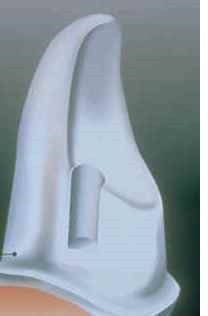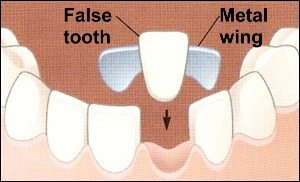Greetings Dr. Hall,
My 12-year-old daughter is genetically missing #10, the maxillary left permanent lateral incisor. We had orthodontic treatment done to move the teeth far enough apart to put in a replacement tooth with an implant. That was completed in December. She now has a permanent wire bonded to the backs of the top 3 center teeth.
Since she is too young for a dental implant right now, we opted to go for a Maryland bridge at the recommendation of her Orthodonist because we did not want to have her deal with an upper Hawley through her teen years. Two weeks ago (after taking impressions and slightly preparing teeth #9 & #11 about a month ago), our family dentist put in her Maryland Bridge. There was no metal on it and she cemented the two non-metal wings to the adjacent teeth. The next day we got new impressions for a new retainer and then the next morning, the Maryland Bridge fell out. She ordered a different type of cement and yesterday evening the same bridge was replaced; this morning while eating a waffle the bridge fell out again.
Now, the Orthodontist and Dentist want to make her a new Maryland Bridge with metal wings instead. Here are my concerns/ questions in which I am looking for an expert second opinion:
1. Will the metal wings on the bridge allow it to affix better to her teeth, lasting at least 5-6 years until we can get the implant?
2. Will there be damage to her permanent teeth (#9 & #11) when the Maryland Bridge is put on AND later taken off? I would like to avoid her needing unnecessary dental work on #9 & #11.
3. Cosmetically, will the metal wings make more of a difference than when they were porcelain? Since this is in the very front of her smile, it is so important that the blend is as close to perfect as can be. I am concerned that irreparable damage could occur on #9 & #11 (not to mention the self esteem of a tween girl at risk here due to this cosmetic, yet genetic flub.) Any advice and opinions are appreciated.
We are going back to the dentist next week for new impressions and for a new Maryland bridge with metal wings to be made (which I am not paying any additional money for.) Also, is there a price difference generally in the bridge that is all porcelain versus one with metal wings? Just curious.
Thank you for taking the time to read this, it is TRULY appreciated. I just want to do what is best for now and especially for her future dental needs.
– Makisha from Arizona
(see Dr. Hall’s response below)
|
.
|
Makisha,
I’m sure your dentist is well-intentioned, but she does not appear to be an expert in cosmetic dental bonding. And I would not let her do a metal-backed Maryland bridge, because I believe the same thing will happen, and I will explain why. There is a much easier, less invasive way to handle this.
Maryland bridges can work well, but it’s not just a simple matter of making space for the wings and then bonding it on. There has to be some preparation done, and in that preparation there has to be what is called resistance form created in the teeth to which the bridge is bonded. There have to be some grooves or something placed to keep the bridge locked onto the teeth – you can’t rely on just the bonding to do it. So when you made reference to “slightly preparing” the adjacent teeth, that spelled trouble. The number one reason that Maryland bridges come off is inadequate preparation.
Here’s a picture of a  front tooth with a groove similar to the type of groove that would help this Maryland bridge stay in place. This is deeper than would probably be required here, but you get the idea.
front tooth with a groove similar to the type of groove that would help this Maryland bridge stay in place. This is deeper than would probably be required here, but you get the idea.
So your dentist did this “slight preparation,” and the bridge came off. She theorizes it must be the cement – let’s try a stronger cement. Nope, comes off again. Now she theorizes it must be the zirconia – if we switch to metal, it will stay on. No, it won’t work, because the problem isn’t in the materials, it’s in the design.
Now she could go back and do the proper grooves or whatever is required to get the bridge to stay on, but then it makes no sense to do a dental implant later. The main reason for doing a dental implant is to avoid having to prepare the adjacent teeth. Once they’re prepared, you may as well stick with the bridge.

A flipper partial replacing a single lateral incisor
The easy solution here is to do what we call a flipper partial. It’s just a false tooth affixed to a small plastic plate that fits behind her teeth and snaps on with metal clips in the back. In some cases the clips aren’t even necessary. But even when clips are used, people can’t see them. I’ve seen these hold up for many years and look extremely natural on very attractive women. A Maryland bridge isn’t an appropriate temporary restoration because the teeth have to be prepared. And if the preparation is adequate enough to hold the bridge in, it will later need to be filled in. It’s against my sensibilities to permanently prepare teeth for a temporary restoration.
So, to answer your questions:
1. Will the metal wings allow the bridge to affix better to her teeth?
No – no way. In fact, I wouldn’t be surprised to hear that the dentist has more trouble bonding the metal on than the zirconia metal-free version. Metal is harder for most dentists to bond.
2. Will there be damage to the teeth?
Yes. There already has been some damage by the “slight preparation” and there will be more damage if your dentist keeps at this, especially if she finally gets it right and prepares the teeth enough so that the bridge will stay on.
3. Is the metal in the bridge a cosmetic problem?
Yes. The metal will darken the adjacent teeth. This is why dentists are moving toward metal-free Maryland bridges.
I’m guessing that your current dentist should have no problem making a flipper partial that will work for your daughter. If you run into any trouble, get back with me and I’ll refer you to someone who can do this right.
– Dr. Hall
Do you have a comment? We’d love to hear from you. Enter your comment below.
Click here to ask Dr. Hall a question of your own.
About David A. Hall
Dr. David A. Hall was one of the first 40 accredited cosmetic dentists in the world. He practiced cosmetic dentistry in Iowa, and in 1990 earned his accreditation with the American Academy of Cosmetic Dentistry. He is now president of Infinity Dental Web, a company in Mesa, Arizona that does advanced internet marketing for dentists.

